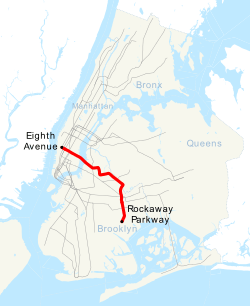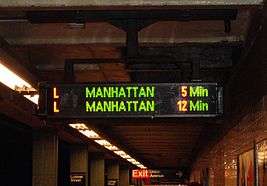L (New York City Subway service)
| 14th Street–Canarsie Local | |
|---|---|
 | |
|
| |
|
A train made of R160 cars in L service at New Lots Avenue, bound for Manhattan. | |
 | |
| Northern end | Eighth Avenue |
| Southern end | Rockaway Parkway |
| Stations | 24 |
| Rolling stock |
168 R143s (21 trains, AM rush) 24 R160As (3 trains, AM rush) 152 R143s (19 trains, PM rush) 16 R160As (2 trains, PM rush) |
| Depot | East New York Yard |
| Started service | June 30, 1924 |
The L 14th Street–Canarsie Local is a rapid transit service in the B Division of the New York City Subway, providing full-time service along the entire length of the two-tracked BMT Canarsie Line and its route emblem, or "bullet", is colored light slate gray.[1] The L operates between Eighth Avenue in Chelsea, Manhattan, and Rockaway Parkway in Canarsie, Brooklyn. It also briefly enters Queens at Halsey Street, serving the neighborhood of Ridgewood.[2] It is the first New York City Subway service to be automated using communications-based train control.
History
Early history
The L, being a local train, was originally given the LL designation when letters were assigned to the BMT division. From 1928 to 1967, the same service was assigned the BMT number 16.
In 1924, part of the eventual 14th Street–Canarsie Line opened, called the "14th Street–Eastern District Line" (commonly the "14th Street–Eastern Line"), and was given the number 16. This was extended east, and in 1928 it was joined to the existing BMT Canarsie Line east of Broadway Junction. Since that time, the 14th Street–Canarsie Line service has operated as it is today, except for an extension from Sixth Avenue to Eighth Avenue, which opened on May 30, 1931 to connect to the new Eighth Avenue Subway. The Eighth Avenue Terminal was originally built in IND style and has been restored to BMT style like Fulton Street and Broad Street. During rush hours, express service ran nonstop between Lorimer Street and Myrtle–Wyckoff Avenues. (Locals usually ran from Eighth Avenue to Myrtle–Wyckoff Avenues or Atlantic Avenue at these times.)[3]
Starting on September 23, 1936, express trains ran to Lefferts Boulevard via the connection with the Fulton Street Elevated at Atlantic Avenue. This connection was severed on April 30, 1956; then the service ran to Canarsie–Rockaway Parkway again, but was discontinued on August 23. The R27 to R38's roll signs had both L and LL for express and local service, even though the express never ran thereafter. (Skip-stop was proposed in the 1990s.)
On November 26, 1967, with the opening of the Chrystie Street Connection, the BMT Eastern District lines were given letters; the 16 became the LL. When double letters were dropped on May 5, 1985, the LL became the L, and it still has that designation.[4]
Before the 14th Street–Eastern and Canarsie Lines were connected, the Canarsie part of the line already had a number, 14, running from Lower Manhattan via the Broadway Elevated and called the Canarsie Line. When the 14th Street–Eastern Line was connected in 1928, this was renamed the Broadway (Brooklyn) Line, but continued to operate to Rockaway Parkway. In 1967, the 14 Canarsie service was given the label JJ (though the 14 itself was designated KK, continuing east from Broadway Junction towards Jamaica). Canarsie service to Lower Manhattan was discontinued in 1968.
2000s-present
Annual ridership for the L service:[5]
- 1994 . . . 16,968,025
- 1996 . . . 18,107,243
- 1998 . . . 21,196,693
- 2000 . . . 26,155,806
- 2005 . . . 30,452,319
Headways:[5]
- Morning and evening rush hours: 4 minutes
- Midday: 6–8 minutes
- Overnight: 20 minutes
The 5 busiest stations in 2005:[5]
- First Avenue, Manhattan
- Bedford Avenue, Williamsburg, Brooklyn
- Canarsie–Rockaway Parkway, Canarsie, Brooklyn
- DeKalb Avenue, Bushwick, Brooklyn
- Graham Avenue, Williamsburg, Brooklyn
The stations with greatest ridership increases in 2014:[6]
- Bushwick Avenue–Aberdeen Street, Bushwick, Brooklyn
- Wilson Avenue, Bushwick, Brooklyn
- Jefferson Street, Bushwick, Brooklyn
Ridership on the L has increased dramatically since 2000, since many neighborhoods along the route have experienced gentrification. The Metropolitan Transportation Authority's $443 million fleet of subway cars on the L was introduced in 2002, but by 2006 was already too small to handle growing ridership. The Transit Authority had projected that 212 Kawasaki-made R143 subway cars would be enough to accommodate ridership demands for years to come, but ridership has risen higher than expected. Sixty-four new R160A cars made by Alstom have been equipped to run on the L.
In 2008, L service was increased and some AM rush hour short turns to Myrtle–Wyckoff Avenues were added.
The BMT Canarsie Line tracks have been undergoing an extensive retrofit over to CBTC, a system that will transfer control of the trains to a computer on board, as opposed to the current system, where the trains are manually operated by a human operator. This was completed in April 2012.[7] While the retrofit has resulted in nearly two years of service changes and station closings, this system will eventually allow trains to run closer together, and enable in-station "countdown clock" displays to note the exact time until the next train arrives. The line also used OPTO (one person train operation) beginning in June 2005, but a combination of public outcry due to perceived safety issues, which increased after the July 2005 London tube bombings, heavy lobbying by the Transport Workers Union of America (TWU), as well as an arbitration ruling that MTA had breached its contract with TWU caused the Metropolitan Transportation Authority to end OPTO the following September. However, the MTA's successful implementation of countdown clocks on the L has been the first in the system.[8]
From January 2019 to at least July 2020, service will be suspended between Eighth Avenue and Bedford Avenue due to planned repairs in the tunnels under the East River damage caused by Hurricane Sandy in 2012.[9]
Route
Service pattern
The L uses the following lines with the same service pattern at all times.
| Line | From | To | Tracks |
|---|---|---|---|
| BMT Canarsie Line | Eighth Avenue | Canarsie–Rockaway Parkway | all |
Stations
For a more detailed station listing, see BMT Canarsie Line.
| Station service legend | |
|---|---|
| |
Stops all times |
| |
Stops all times except late nights |
| |
Stops weekdays only |
| |
Stops rush hours in the peak direction only |
| |
Station closed |
| |
Stops weekdays in the peak direction only |
| Time period details | |
References
- ↑ http://web.mta.info/developers/resources/line_colors.htm
- ↑ "Queens Bus Map" (PDF).
- ↑ Line by line history L train
- ↑ "Hey, What's a "K" train? 1985 Brochure". Flickr - Photo Sharing!. Retrieved 2016-06-17.
- 1 2 3 Donohue, Pete (July 7, 2006). "Oh, L, Not Enuf Trains!". Daily News. New York. Retrieved 2010-03-20.
- ↑ Mays, Jeff (21 April 2015). "MAP: See How Much Subway Ridership Increased at Your Station". DNA Info. Retrieved 5 May 2015.
- ↑ MTA Capital Program Milestones Report
- ↑ MTA/Siemens train-arrival sign
- ↑ Fitzsimmons, Emma G. (July 25, 2016). "L Train Will Shut Down Between Manhattan and Brooklyn in '19 for 18 Months". The New York Times. Retrieved July 25, 2016.
External links
| Wikimedia Commons has media related to L (New York City Subway service). |
- MTA NYC Transit – L 14th Street – Canarsie Local
- "L Subway Timetable, Effective November 7, 2016" (PDF). New York Metropolitan Transportation Authority. Retrieved November 7, 2016.







